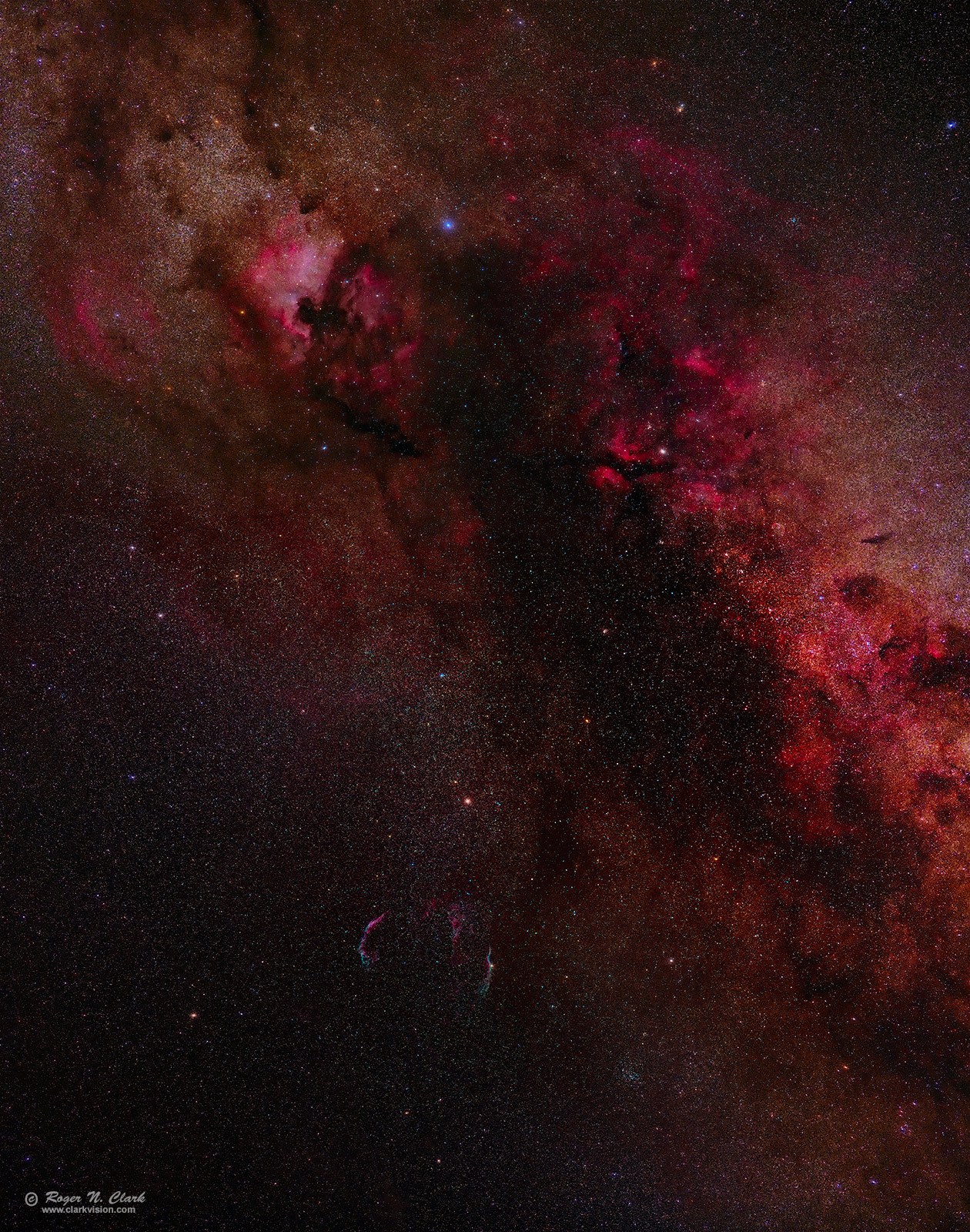| Home | Galleries | Articles | Reviews | Best Gear | New | About | Contact | Gallery Index | Previous |
Next |

| Home | Galleries | Articles | Reviews | Best Gear | New | About | Contact | Gallery Index | Previous |
Next |

The Constellation Cygnus, the Swan, contains many deep-sky object visible to Northern Hemisphere observers in the summertime. Prominent in this image in the upper left is the North America nebula, and to its right is the brightest star in the constellation, Deneb. Below center are the delicate arcs of the Veil nebula, an ancient supernova remnant and beautiful sight in amateur telescopes from a dark site. Red/pink hydrogen emission nebulae are scattered throughout the image. The plane of the Milky Way galaxy rund from lower right to upper left.
The new amazing Sigma 105mm f/1.4 DG HSM Art Lens on a Canon EOS 6D Mark II DSLR Camera provided this stunning image. The camera is stock, and the fact that it picket up so much hydrogen emission show that it is very sensitive.
Technical. This image was obtained with a Canon EOS 6D Mark II DSLR Camera and Sigma 105mm f/1.4 DG HSM Art Lens at f/1.4 and ISO 1600. No dark frame subtraction, no flat fields. Tracking with a Fornax Lightrack II and no guiding. This is a 3-frame mosaic, with the camera in landscape orientation. Each exposure was 30 seconds. The top frame is a stack of 28 images, the middle 18 image and the bottom 42 images. No noise is apparent in the image--those are all stars. The total exposure was 14 minutes (top), 9 minutes (middle), and 21 minutes (bottom). The full resolution image plate scale is 11.2 arc-seconds per pixel. The image presented here is at 52 arc-seconds per pixel.
Post processing: Raw conversion with Rawtherapee with settings tuned for astrophotos, including maintaining star color in saturated stars. Output color space was Rec.2020 to match the future of high dynamic range TVs. Look for a future article on this topic. Stretched with rnc-color-stretch. Then an aggressive star reduction in ImagePlus. Also see Astrophotography Image Processing Basic Work Flow.
This is a natural color image. The high dynamic range of astrophotos must be stretched to bring out the range of details the camera recorded. But the typical image stretch process loses color for brighter subjects (e.g. stars and the brighter parts of deep sky objects become whiter as they are made brighter). This image uses a new algorithm that does not lose color during the stretch. The new algorithm enables fainter details to be shown and with less noise. Learn about the new software and download it free (open source) here: rnc-color-stretch.
The Exposure Factors, CEF, CEFA are measures of the relative amounts of light received from a subject. It can be used to fairly compare wildly different lens/telescope apertures and exposure times. For this image:
Modern DSLRs like the 6D Mark II include on sensor dark current suppression and low fixed pattern noise at ISOs around 1600 and higher, making no need for dark frame subtraction. Modern raw converters correct for light fall-off and also correct for hot/dead/stuck pixels. This makes processing low light images easy: simply align and average.
To learn how to obtain stunning images like this, please visit my Extensive Articles on Photography .
Keywords to this image = astrophoto-1 galaxy Messier nebula star_cluster night low-light digital_astro mosaic canon_6D2
Image ID: cygnus-105mm-6d2-mosaic-rnclark-img4840-4929-c08-11-2018-g3-b-1600vs.jpg
| Home | Galleries | Articles | Reviews | Best Gear | Science | New | About | Contact |
Last updated December 20, 2025